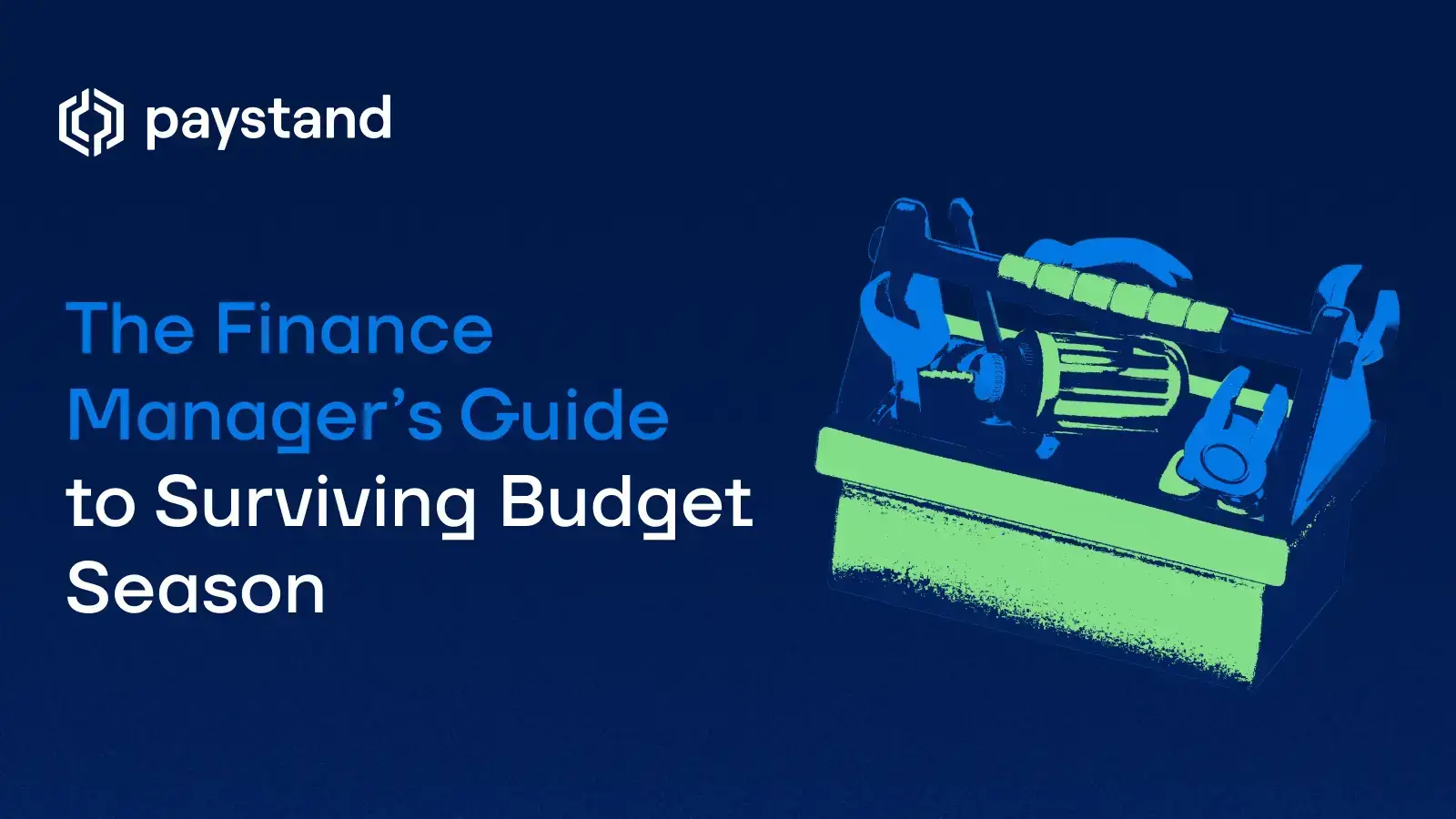The Finance Manager’s Guide to Surviving Budget Season

Table of Contents
- What is Budget Season?
- Strategic Steps to Navigate Budget Season
- Best Practices to Master Budget Season
- How AR and AP Automation Simplifies Budget Season Processes
- Automate AR and AP Processes with Paystand
- Budget Season FAQs
Key Takeaways
- Budget season is the annual period when organizations create financial plans for the upcoming fiscal year, typically lasting 3-6 months and involving data collection, forecasting, and approval processes
- Successful budget preparation requires early timeline establishment and a realistic framework that balances departmental needs with company resources
- Modern automation tools eliminate manual data entry and streamline approval workflows that transform budget season into a strategic planning advantage
- AR and AP managers can leverage payment automation and cash flow forecasting tools to create more accurate budget projections while reducing administrative burden
Budget season strikes fear in the hearts of even the most seasoned finance managers and accounting professionals, bringing sleepless nights and Excel-induced headaches. But what if you could transform those painful processes and turn your department into a strategic asset for your business?
This comprehensive guide shows you how you can transform your annual budgeting nightmare into a strategic advantage. You will learn key frameworks and actionable tactics needed to master the process while preserving your sanity.
What is Budget Season?
Budget season is the annual period when organizations create, review, and finalize their budgets for the upcoming fiscal year. This intensive process typically spans 3-6 months and involves analyzing past financial performance, forecasting future revenue and expenses, and setting spending limits for each department.
The timing varies by organization, but most companies begin budget preparation 4-6 months before their fiscal year starts. During this period, finance teams collect data from multiple sources, coordinate with department heads, and navigate competing priorities to create a comprehensive financial plan.
Budget season matters because it establishes the financial framework that guides business decisions throughout the year. The budgeting process helps leaders allocate resources, set performance targets, and identify potential cash flow challenges before they become critical problems.
The Complete Budgeting Cycle
- Planning and proposal submission: Department heads translate strategic goals into specific budget requests
- Review and consolidation: Finance teams analyze requests against available resources and company priorities
- Approval to implementation: Final budgets are communicated and integrated into operational systems
- Monitoring and adjustment: Ongoing variance analysis identifies areas requiring attention or modification
Types of budgeting methods
Different organizations use various budgeting approaches depending on their industry, size, and strategic priorities. Traditional budgeting builds on the previous year's budget with incremental adjustments, making it suitable for stable organizations with predictable expenses.
Zero-based budgeting starts from scratch, requiring every expense to be justified regardless of historical spending patterns. This method works well when cost control is a priority or when organizations need significant realignment.
Rolling budgets continuously update projections for a fixed period ahead, typically 12-18 months. This approach suits dynamic environments where frequent adjustments are necessary to maintain accuracy.
|
Budget Type |
How it works |
Best for |
Time investment |
|
Traditional |
Builds on prior year with adjustments |
Stable operations |
Low |
|
Zero-Based |
Justifies all expenses from scratch |
Cost control focus |
High |
|
Rolling |
Continuously updates fixed period |
Dynamic environments |
Medium |
|
Activity-Based |
Links costs to specific activities |
Detailed cost analysis |
High |
Strategic Steps to Navigate Budget Season
Successful budget season navigation requires a systematic approach that balances thorough preparation with realistic timelines. AR managers who follow structured processes experience less stress and produce more accurate financial plans.
Step 1: Establish Your Budget Timeline and Milestones
Creating a detailed timeline prevents last-minute scrambling and ensures adequate time for each phase of the budgeting process. Start by working backward from your board meeting or final approval date, then add buffer time between major milestones.
Most organizations allocate 2-3 weeks for initial data collection, 3-4 weeks for department input and review, and 1-2 weeks for final consolidation and approval. Include extra time for unexpected delays or additional analysis requests.
Critical milestones typically include:
- Initial data collection and analysis completion
- Department budget submission deadlines
- First draft consolidation and review
- Executive presentation and approval
- Final budget communication and system updates
Step 2: Identify and Engage Key Stakeholders Early
Key stakeholders include department heads who provide operational input, executives who set strategic direction, and finance team members who ensure accuracy and compliance.
Early engagement prevents surprises and builds buy-in for the final budget. Send calendar invites well in advance, clearly communicate expectations, and provide templates or guidelines that standardize input formats.
Regular check-ins during the process help identify potential issues before they become problems. Consider weekly status meetings during peak budget season to maintain momentum and address questions quickly.
Step 3: Gather Historical Data and Set Initial Projections
Collect at least three years of actual results, including monthly details that show seasonal variations.
Compare actual results against previous budgets to identify consistent variances. For example, if marketing consistently spends 15% more than budgeted in Q4, factor this pattern into your new projections.
Key data sources include:
- Monthly financial statements and general ledger details
- Accounts receivable aging reports and collection metrics
- Customer payment patterns and bad debt history
- Department spending reports and variance analyses
- Industry benchmarks and economic forecasts
Step 4: Create a Realistic Budget Framework
Start with major expense categories like personnel, technology, and operations, then break these down into subcategories that align with your chart of accounts.
Balance top-down guidance from leadership with bottom-up input from operational teams. Build in contingency reserves for unexpected expenses or revenue shortfalls.
Most organizations allocate 3-5% of total budget as contingency, though this varies by industry and risk tolerance.
Step 5: Align Your Budget With Business Goals
Create clear links between financial allocations and strategic initiatives to ensure resource alignment.
Document the reasoning behind major budget decisions, especially when allocations differ significantly from historical patterns. This documentation supports budget defense during review meetings and provides context for future planning cycles.
Regular alignment checks during the budgeting process help identify disconnects between stated priorities and resource allocation. If customer acquisition is a top priority but marketing budgets are flat, address this inconsistency before finalizing plans.
Step 6: Conduct Review Sessions
Send detailed agendas and supporting materials at least 48 hours before meetings. Include preliminary budget allocations, variance explanations, and specific questions requiring departmental input. This preparation time allows participants to review data and develop thoughtful responses rather than reacting defensively.
Frame discussions around questions like "What capabilities does this investment enable?" and "How does this allocation support our strategic priorities?" This approach shifts conversations from budget defense to strategic alignment.
When disagreements arise, focus on underlying business needs rather than budget amounts. Often, creative solutions emerge when teams explore alternative approaches to achieving the same objectives with different resource configurations.
Step 7: Finalize and Document Your Annual Plan
Create narrative explanations for major budget assumptions, particularly those involving significant changes from historical patterns. Document the reasoning behind revenue growth projections, headcount plans, and capital investments.
When circumstances change mid-year, this context enables informed adjustments rather than arbitrary cuts.
Include scenario analyses that model different business conditions and their budget implications. Document the triggers that would activate contingency plans and the specific actions required under each scenario.
Step 8: Communicate the Budget to all Relevant Teams
Tailor communication approaches to different audiences based on their roles and information needs. Executive teams require strategic context and high-level summaries, while operational managers need detailed breakdowns of their specific allocations and spending authorities.
Establish regular check-in cadences for budget performance reviews before the fiscal year begins. When teams know monthly or quarterly reviews are scheduled, they maintain focus on budget execution rather than treating it as a one-time planning exercise.
Address the "why" behind budget decisions, particularly when allocations differ from departmental requests. Teams accept resource constraints more readily when they understand the broader context and competing priorities that shaped final decisions.
Best Practices to Master Budget Season
These practices help finance managers reduce stress, improve outcomes, and create more sustainable budgeting workflows.
Balance Competing Priorities Across Departments
Use structured decision-making frameworks that evaluate requests against objective criteria like strategic alignment, ROI potential, and operational necessity.
Facilitate discussions where departments present their cases directly to each other, not just to finance leadership. This transparency often leads to creative solutions and mutual understanding of trade-offs.
Forecast and Mitigate Late Payments and Bad Debt
Analyze historical collection patterns, customer payment trends, and economic indicators that might affect future performance.
Build contingency plans for different collection scenarios, including best-case, worst-case, and most likely outcomes. This scenario planning helps identify early warning signs and response strategies.
Consider seasonal patterns, customer concentration risks, and industry-specific payment cycles when projecting cash flows. Manufacturing customers might pay slower during plant shutdowns, while retailers might accelerate payments before peak seasons.
Set and Achieve Realistic Revenue Goals
Base projections on detailed analysis of sales pipelines, customer contracts, and market conditions rather than aspirational targets.
Test assumptions through scenario modeling that examines different growth rates, customer retention levels, and market conditions. This analysis helps identify the most likely outcomes and appropriate contingency planning.
Monitor Performance and Make Adjustments
Establish trigger points that signal when intervention is needed, such as variances exceeding 10% or missing monthly targets two months in a row.
Monthly variance analysis examines both favorable and unfavorable differences from budget. Understanding why performance exceeded expectations is as important as addressing shortfalls.
Create dashboard reports that highlight key metrics and trends for stakeholders who don't need detailed financial statements. Visual representations of budget performance facilitate quicker decision-making and course corrections.
Conduct Year-over-Year Improvement Analysis
Begin by comparing actual versus budgeted figures across at least three fiscal years to identify persistent patterns. Focus on both quantitative metrics (collection rates, DSO, write-offs) and qualitative factors (process efficiency, team capacity).
Document significant variances and investigate root causes—was the forecast flawed or did execution falter? Create standardized templates for this analysis to ensure consistency. The goal is to identify where you missed targets, why, and implement process improvements.
Engage Your Team in the Budgeting Process
Budget ownership shouldn't rest solely with finance leaders. Involve your staff from the earliest planning stages by soliciting their insights on customer payment behaviors, collection challenges, and process bottlenecks.
These frontline perspectives often reveal opportunities that top-down analysis misses. Hold collaborative workshops where team members can contribute to realistic target-setting based on their daily experiences.
When staff participate in creating goals, they become invested in achieving them. This inclusive approach not only improves budget accuracy but also develops financial literacy across your organization, creating a team that thinks and acts with budget awareness.
Enforce Budget Discipline Throughout the Year
Create accountability by incorporating budget adherence into performance evaluations and incentive structures. Deploy visualization tools like dashboards that make budget status immediately apparent to decision-makers.
When variances occur, document them promptly along with corrective actions. This disciplined approach prevents the all-too-common scenario where budgets are created with great fanfare only to be forgotten until the next planning cycle begins.
How AR and AP Automation Simplifies Budget Season Processes
Modern automation tools transform budget season from a manual, error-prone process into a streamlined, data-driven exercise. The result is more accurate budgets completed in shorter timeframes.
Automated Data Collection and Analysis
Automated systems eliminate manual invoice processing and payment reconciliation. They reduce errors and provide finance teams with accurate accounts payable aging reports for better budget projections.
These tools also integrate directly with ERP systems to ensure data consistency.
Real-time data collection means budget projections reflect current performance rather than outdated information. This accuracy improves throughout the budget cycle as systems continuously update with new transactions and payments.
Automation benefits include:
- Error reduction: Eliminates manual data entry mistakes that compound through budget calculations
- Time savings: Reduces data collection time from weeks to days
- Consistency: Standardizes data formats and calculation methods across departments
- Audit trails: Provide complete documentation of data sources and processing steps
Streamlined Approval Workflows
Digital approval processes create predictable payment schedules that improve cash flow planning accuracy. Finance teams can forecast outgoing payments with greater precision, leading to better working capital management.
Automated notifications keep stakeholders informed of pending approvals and potential delays. This transparency reduces bottlenecks and ensures budget deadlines are met consistently.
Real-Time Reporting and Performance Tracking
Automated reporting tools provide immediate visibility into accounts receivable collections, accounts payable payment cycles, and cash flow trends. This real-time visibility enables early detection of performance issues that might affect budget assumptions.
For example, declining collection rates or extending payment terms become apparent immediately rather than weeks later.
Dashboard reporting summarizes key performance indicators in visual formats that facilitate quick decision-making. Stakeholders can identify trends and anomalies without reviewing detailed financial statements.
Automate AR and AP Processes with Paystand
For AR and AP managers ready to transform budget season from an annual ordeal into a strategic planning advantage, Paystand eliminates manual processes while providing the real-time visibility needed for accurate financial planning.
- Zero-fee digital payments through a proprietary blockchain network that eliminates transaction costs and improves budget predictability
- Automated invoice processing and reconciliation that reduces finance team workload while providing accurate data for budget projections
- Real-time cash flow visibility that enables more precise forecasting and strategic payment timing decisions
- Seamless ERP integration that connects payment data directly with budgeting and financial planning systems
Discover how Paystand can transform your budget season experience while eliminating payment processing fees from your operations.
Budget Season FAQs
How do you balance aggressive collection targets with maintaining positive customer relationships during budget planning?
Balancing collection targets with customer relationships involves setting realistic expectations based on historical performance and customer payment patterns. Build contingency plans that account for relationship preservation while meeting cash flow objectives.
What contingencies should AR managers build into budgets for economic uncertainty?
Economic contingencies typically include increased bad debt reserves, extended payment terms assumptions, and scenario planning for different collection rates. Most organizations increase bad debt allowances by 25-50% during uncertain economic periods.
How often should budgets be reviewed and revised throughout the fiscal year?
Budget reviews commonly occur quarterly, with monthly monitoring of key metrics and variances. Organizations in volatile industries may conduct monthly formal reviews, while stable businesses might review semi-annually.
What's the most effective way to justify AR automation investments during budget planning?
Automation justification relies on cost-benefit analysis comparing current manual processing costs with projected efficiency gains. Include both direct savings from reduced labor and indirect benefits from improved accuracy and faster processing.
Which KPIs are most important for measuring budget performance in accounts receivable?
Critical AR KPIs include days sales outstanding (DSO), collection effectiveness index, bad debt ratio, and cash application accuracy. These metrics provide comprehensive visibility into collection performance against budget assumptions.
How can AR managers align their budgets with overall company objectives?
Budget alignment occurs through mapping AR goals directly to company priorities like cash flow improvement, customer satisfaction, or operational efficiency. Document these connections clearly in budget presentations and regular performance reviews.
What's the best approach for handling budget requests that exceed available resources?
Resource allocation decisions benefit from objective criteria, including strategic importance, ROI potential, and operational necessity. Prioritization matrices help compare competing requests using consistent evaluation standards.
How should inflation be accounted for in multi-year AR budget planning?
Inflation adjustments typically apply expected rates to personnel costs, technology expenses, and service contracts. Use economic forecasts and historical data to select appropriate inflation factors for different expense categories.
What are the most common mistakes made during the budgeting process?
Common budgeting mistakes include underestimating collection challenges, overestimating automation benefits, failing to account for seasonal variations, and inadequate stakeholder communication throughout the process.
How can finance managers make the budgeting process more efficient without sacrificing accuracy?
Efficiency improvements come from standardized templates, automated data collection, and regular communication schedules. Invest time in process documentation and stakeholder training to reduce confusion and rework.







